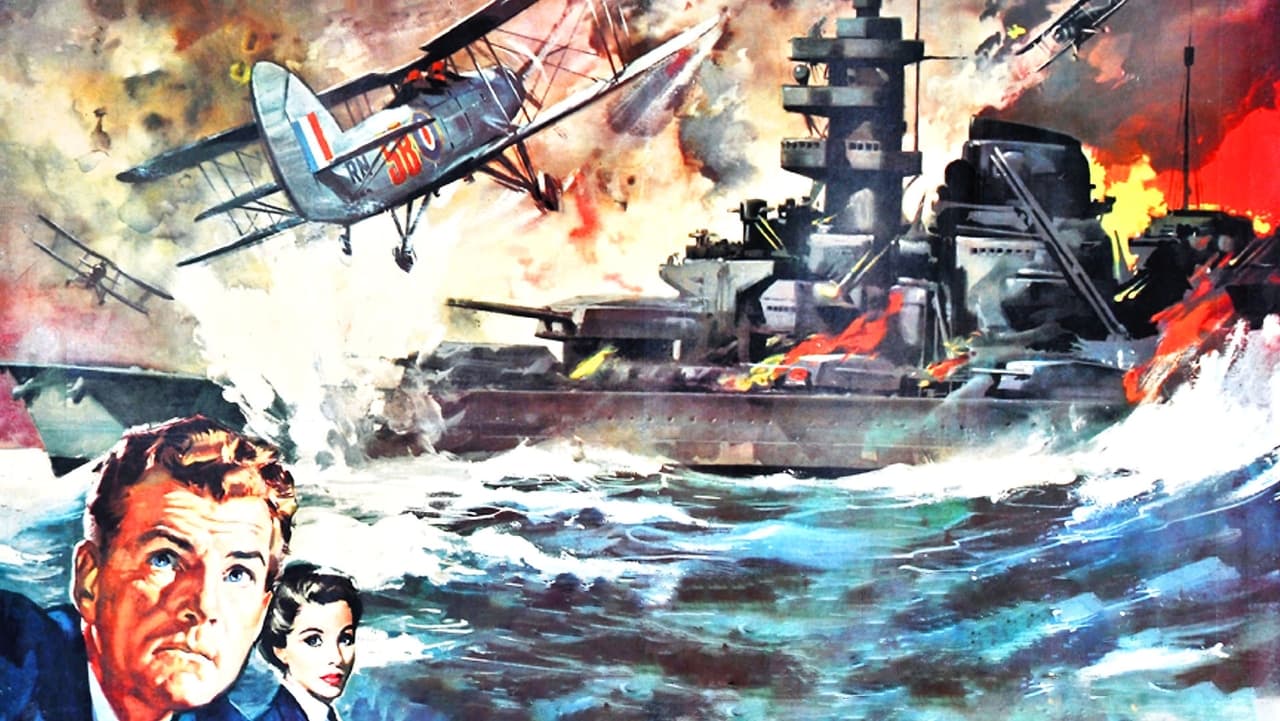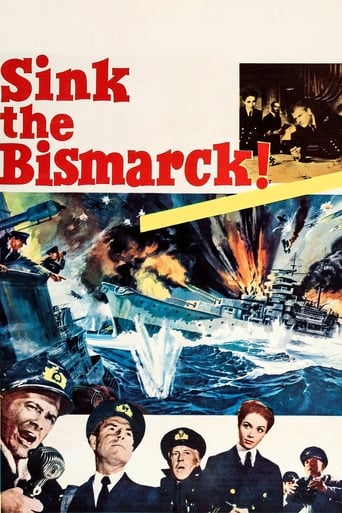

I may be one of those few who think that a more exciting flick about the Bismarck would have been achieved had those making this movie stuck to the real story and focused entirely on it. Not that I am against the "human touch" or romantic love in films like this, but I think the Bismarck saga is a far more exciting war epic that is shown in STB! and so deserves the whole and undivided attention of an audience.First, to back my point, some facts that I don't see much mentioned, yet which are essential to the story: a) The Bismarck losing the shadowing cruisers had nothing to do with Lutjens' brilliancy and everything to do with luck. Both ships started zigzagging out of fear of possible U subs nearby so they went for 10 mins. to left, then 10 mins. to right, so every time they reached the most outward points they lost the Bismarck for a few minutes. It was during one of these occasions that, coming back, they realized they hadn't her anymore in their screens. b) The Bismarck being located again wasn't either the result of any brilliant hunch but simply the fruit of Lutjens's pessimism and of his overestimation of the British radar—he gave it a range bigger than it really had—belief which made him think that he still had them in his wake when he sent to Paris a 30 min. message depicting in detail past events, giving the Brits time enough to locate his ship through radiogoniometers--not that the Brits did any better then: they fumbled the data and gave the Germans yet another crucial advantage which was eventually neutralized by the torpedo hit on the rudder. (By then they knew she was going to St. Nazaire anyway, the closest friendly port, sort of, where the Germans could fix a +50.000-ton ship.)c) Speaking of which, that torpedo hit on the rudder could have never happened: as HMS Ark Royal was rushing to the scene she was spotted by U 556, which could have readily sunk her with torpedoes. But it didn't do it because it didn't have any left, it had just spent them all.d) The Bismarck was a condemned ship anyway as his design was already outdated, the result of Germany having been prevented from developing any serious naval research during wars. The result of it were dramatic: use of dual main batteries while other navies were already working with triple or quadruple batteries. Lack of dual purpose secondary guns, for both surface and AA fire. Great amount of room on decks wasted on lifeboats--instead of inflatable boats--room that could have been better spent on AA guns of all calibers, their failure at shooting down even one Swordfish WWI relic makes this point well.e) On the plus side, a few advantages that even if very impressive wouldn't have made a difference: it could fire her 15" much faster than her RN opponents, one shot every 22 seconds.--acc. to Von Mullenheim Rechberg--to one each 45 sec. Superb fire control, with the best optical instruments available at the time. And Krupp steel of course.As space runs out I resume: not really a very accurate reenactment of a true life event as the other More historical flick was, much more of a war propaganda movie with a human touch. Yet still very aptly done and more entertaining than it seems, with More and the rest playing it to a tee. Some superfluous melodrama, though, in a few scenes. And as in ANTR it takes you to the heart of the action on the condition that you know little or nothing about the subject matter. The less you know about it the more chances you'll have to enjoy it. 7/10.
... View MoreA distinguished wide-screen film that honors those who served in a great British naval episode while showing generally how naval warfare was carried out in the early days of WWII.Effectively portraying the sheer power of one of the most monstrous weapons ever devised by the dark side of the human mind- the battleship Bismarck. Battleships had a hideous, graceful sort of massive beauty during their brief heyday at the peak of war technology but went the way of the dinosaur after WWII. Their vulnerabilities are demonstrated in this film, as are certain unfortunate (but not necessarily erroneous) tactical moves by the German Admiral and the Captain of the Bismarck.In case you don't know the story I won't spoil it but an event occurs around the middle of this film that has a sudden awesome shock value that can still cause your jaw to drop. It is perfectly set forth despite the low-tech film techniques available in 1960- the producers do a great job.A deadly serious film about deadly serious heavy subject matter, "Sink the Bismarck" has qualities that hold up and it is worth your viewing time.
... View MoreCelebrated American reporter Edward Murrow appears as himself seemingly recreating his wartime radio broadcasts which add urgency and a documentary style setting to this film. In 1941 the British Navy was stretched to breaking point as they were engaged in the Mediterranean and protecting the North Atlantic convoysGermany launched its naval pride, The Bismarck named after the unifier of modern Germany. In just a few days the Bismarck was sinking Royal Naval ships and causing havoc.The film show the Nazis fighting for the glory of the third Reich and you know there are in trouble when the German admiral describes the new ship as unsinkable. You see the cat and mouse strategy at the Admiralty, as orders are relayed to the few ships over the Atlantic as they engage with the Bismarck. However the film is let down by the miniature sets, you never really believe the Bismarck is this giant warship in the open seas.The film is based on true events but some of the characters such the one portrayed by Kenneth More is fictitious. I had to double check to find out when this film was released, at one point it looks like a wartime propaganda film with Murrow's commentary adding tension and its black and white setting.Yet the film was released in 1960, fourteen years after the was finished yet it seems so old fashioned with its stiff upper lips and rather starched attitudes. I found it rather hard to believe that with Britain on the verge of revolution in its cinema, the rise of the working class actors and kitchen sink dramas that this film turned up as a relic of a bygone age with a plainly old fashioned script and added propaganda. The film The Cruel Sea released in 1953 had more realistic characterisations.Director Lewis Gilbert probably sensed this, a few years later he directed Michael Caine in Alfie, set in swinging London of the mid 1960s and in the mid 1970s he went on to direct one of my favourite James Bond films.
... View MoreThe German battleship Bismarck has set sail for the high seas, sank the HMS Hood and has broken out into the north Atlantic. The powerful force of the Nazi navy seems unstoppable but the Royal Navy will stop at nothing to strike down the floating monstrosity, Winston Churchill orders the brave seamen to SINK THE BISMARCK! A fantastic piece of British cinema showing a realistic and exciting portrayal of one of history's defining battles at sea with amazing performances from Kenneth More and Dana Wynter. The battle scenes at sea between the ships and the air raid from the swordfish bi-planes are all breathtaking scenes and hold up well today. A great war film and a must see 8/10
... View More